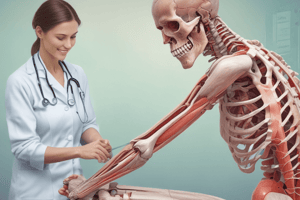Podcast
Questions and Answers
What are the common musculoskeletal discomfort complaints associated with poor ergonomic practices?
What are the common musculoskeletal discomfort complaints associated with poor ergonomic practices?
Common complaints include lower back pain, neck tension, and shoulder discomfort.
How do energy systems contribute to performance and fatigue during physical tasks?
How do energy systems contribute to performance and fatigue during physical tasks?
Energy systems, including aerobic and anaerobic metabolism, provide the necessary ATP for muscle contractions but can lead to fatigue when depleted.
Describe the differences between aerobic and anaerobic metabolism.
Describe the differences between aerobic and anaerobic metabolism.
Aerobic metabolism requires oxygen and produces more ATP, while anaerobic metabolism occurs without oxygen and produces energy quickly but less efficiently.
How does exercise physiology relate to the human body's response to ergonomics?
How does exercise physiology relate to the human body's response to ergonomics?
What role does biomechanics play in evaluating the interaction between tasks and musculoskeletal discomfort?
What role does biomechanics play in evaluating the interaction between tasks and musculoskeletal discomfort?
Explain how perceived effects can differ from actual physical effects on the human body during tasks.
Explain how perceived effects can differ from actual physical effects on the human body during tasks.
Identify the internal human body effects that can arise from inadequate ergonomic design.
Identify the internal human body effects that can arise from inadequate ergonomic design.
What factors can influence an individual's comfort level when interacting with ergonomic products?
What factors can influence an individual's comfort level when interacting with ergonomic products?
What is the connection between reduced active muscle components and musculoskeletal disorders?
What is the connection between reduced active muscle components and musculoskeletal disorders?
How can musculoskeletal discomfort be mitigated during physical tasks?
How can musculoskeletal discomfort be mitigated during physical tasks?
What are the primary differences between aerobic and anaerobic metabolism?
What are the primary differences between aerobic and anaerobic metabolism?
Why is it important to stay in aerobic metabolism during physical tasks?
Why is it important to stay in aerobic metabolism during physical tasks?
What role do muscles play in generating force within the body?
What role do muscles play in generating force within the body?
What causes muscle pain after intense physical activity?
What causes muscle pain after intense physical activity?
How can proper training prevent musculoskeletal disorders?
How can proper training prevent musculoskeletal disorders?
What strategies can be implemented to ensure effective muscle action during physical tasks?
What strategies can be implemented to ensure effective muscle action during physical tasks?
What is the relationship between muscle fiber type and the force produced by muscles?
What is the relationship between muscle fiber type and the force produced by muscles?
Which type of muscle contraction is most likely to lead to musculoskeletal disorders (MSDs)?
Which type of muscle contraction is most likely to lead to musculoskeletal disorders (MSDs)?
How does anthropometry influence ergonomic design?
How does anthropometry influence ergonomic design?
What is the primary role of muscle force in physical ergonomics?
What is the primary role of muscle force in physical ergonomics?
Define concentric and eccentric muscle contractions.
Define concentric and eccentric muscle contractions.
What are the physical characteristics of an ergonomic chair suitable for average users?
What are the physical characteristics of an ergonomic chair suitable for average users?
Why is understanding energy systems important in exercise physiology?
Why is understanding energy systems important in exercise physiology?
Explain the difference between aerobic and anaerobic metabolism in relation to muscle use.
Explain the difference between aerobic and anaerobic metabolism in relation to muscle use.
Flashcards are hidden until you start studying
Study Notes
Internal Human Body Effects
- Internal effects on the human body include musculoskeletal discomfort and perceived effects.
- Musculoskeletal discomfort can be caused by muscle load, and can lead to musculoskeletal disorders (MSDs).
- These effects are influenced by product characteristics, usage, and tasks.
Energy Systems
- Human energy systems operate through aerobic and anaerobic metabolism.
- The body aims to stay in aerobic metabolism, to avoid the build-up of lactic acid and fatigue.
- Staying in aerobic metabolism can be achieved by reducing load, providing sufficient breaks, and ensuring proper training.
Muscle Model
- Muscles consist of a belly and a tendon.
- The belly produces force while the tendon attaches the muscle to the skeleton.
- Muscles can exert different levels of force depending on their structure: Parallel muscle, with small cross-section and longer fibers, produces smaller force; Pennate muscle, with larger cross-section and shorter fibers, produces greater force.
Forms of Muscle Contractions
- Muscles can contract in three ways: concentric, eccentric, and isometric.
- Eccentric contractions are most likely to lead to MSDs.
Anthropometry and Ergonomics
- Anthropometry is the study of human body measurements.
- Products are typically designed for the average user, which may not be ideal for everyone.
- Ergonomics uses anthropometric data to create products that are comfortable and safe for a wider range of users.
Studying That Suits You
Use AI to generate personalized quizzes and flashcards to suit your learning preferences.



